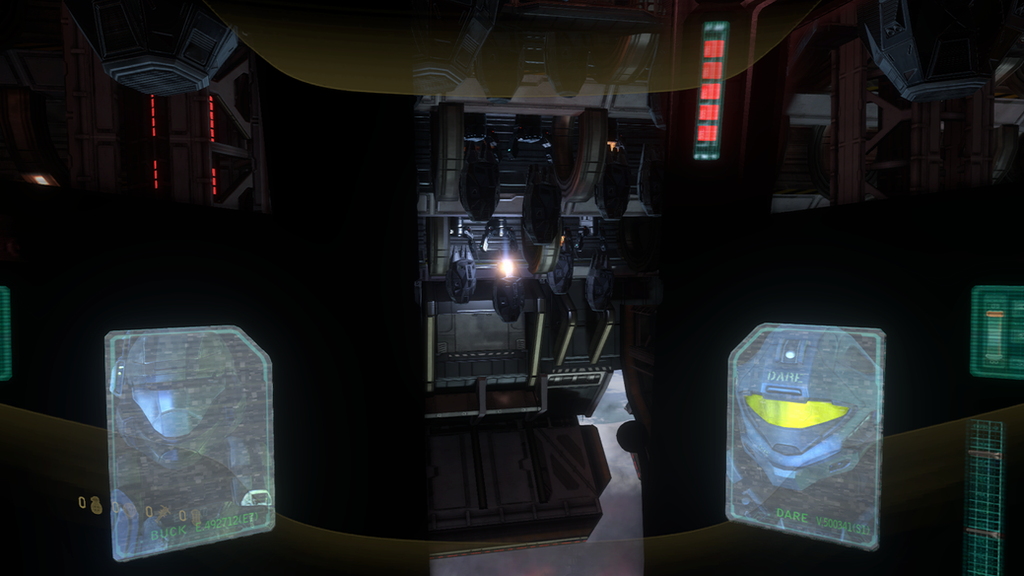HOME | DD
 Turbofurby — Single Occupant Exoatmospheric Insertion Vehicle
Turbofurby — Single Occupant Exoatmospheric Insertion Vehicle

Published: 2017-08-03 22:10:53 +0000 UTC; Views: 733; Favourites: 11; Downloads: 0
Redirect to original
Description
In use for nearly a century, SOEIVs allow for the rapid deployment of ground assault troops near or right onto an objective, a method known as "transorbital support interdiction". Their smaller profiles make them more difficult to destroy by defensive fire than conventional dropships. Despite the dangers related to SOEIV deployment, these drop pods have a lower overall casualty rate in combat than conventional dropship deployment. This is largely due to its occupants being conveyed separately, rather than together in one ship. SOEIVs can also be utilized by a spacecraft making a quick pass over a world, allowing for the deployment of hundreds of soldiers in quick succession. Drop pods have also seen use as ballistic projectiles, capable of destroying Blisterback artillery platforms. Each pod bears the name of the soldier inside; amongst other things this identification could be used to identify the unfortunate occupant of a destroyed pod.UNSC Insertion Protocols call for the commanding officer of an SOEIV-facilitated assault unit to land first to minimize the period of disorder that might occur as pods land and troopers deploy. The reasons for this rule include the strongly held belief that officers should lead rather than follow, should be willing to do anything their troops are asked to do, and should expose themselves to the same level of danger as their subordinates. The commander's pod is equipped with a great deal of equipment that the regular SOEIVs do not possess, including high-powered imaging gear, tactical sensors, and a fourth generation, Class-C military "dumb" artificial intelligence that serves to operate the aforementioned gear. SOEIV usage is popularly associated with the soldiers of the elite Orbital Drop Shock Trooper divisions, although UNSC Special Forces operators and SPARTAN-II supersoldiers are known to use these as one of their primary infiltration methods as well.
The drop pod's operator enters the Single Occupant Exoatmospheric Insertion Vehicle and straps in facing the hatch. The SOEIVs are located in a long, narrow compartment on a ship, colloquially referred to as "Hell's Waiting Room". The room is typically lined with two rows of drop pods. Each SOEIV is poised over a tube that extends downward through the spacecraft's belly. The preparation chambers are often stacked on multiple decks to allow several pods to be deployed via the same tube in rapid succession. To initiate deployment, a pod's operator must run an obligatory systems check, remove a series of safeties, and arm their ejection tube. Generally, the ship's fire control computer is responsible for ejecting the SOEIV at a trajectory that allowed it to drop into the correct entry path. The communications gear built into the SOEIV's hatch feeds the pod's occupant information relevant to the current operation and provides a link between all members of the unit during deployment, in addition to delivering a live video feed of other members of the unit to the pod's operator. A soldier's helmet-integrated communications units are redundant while within a SOEIV, and are normally only used if the pod's own communications gear malfunctions. Their integral helmet-comm gear will not function until the pod has cleared the interference of a world's upper atmosphere.
A 30-second deployment countdown begins on the mark of the commanding officer of the unit. Afterwards, the SOEIVs fire quickly through the tube that runs down ship's belly. The drop pods are typically deployed from either a high altitude or from an exoatmospheric location. They are either fired out of the spacecraft or soft-ejected towards a world's surface until the pod breaches the atmosphere. The SOEIV is balanced to maintain flight stability in a feet-down position. The pod has limited maneuvering capability is primarily used to coordinate landings, but may be used to avoid defensive anti-aircraft fire. However, if defensive anti-aircraft weaponry is present near the deployment point, it is nearly a mathematical certainty that some pods will be lost. It is not uncommon for SOEIVs to be deployed in meteor and other debris showers on a world, as it provides a significant degree of stealth to a unit's deployment.
The SOEIV's ceramic skin burns away during atmospheric re-entry, protecting the rest of the pod and its occupant from the worst of the considerable heat. An alloy crash cage is there to keep the armor from ripping away and to replace the ceramic skin once it burns away. If the ceramic skin that covers a SOEIV is damaged before or during the pod's entry into atmosphere, it has a tendency to fail spectacularly; this often results in the air inside the pod becomes unbelievably hot, sometimes fatally so. This is one of largest contributors for the SOEIV's relatively small size—the destruction of a single pod loss only results in one casualty rather than the deaths of the entire unit. As the pod's ceramic skin strips off, the interior of a SOEIV can reach temperatures as high as 37°C (98°F).
At this point in the re-entry procedure, the pod is free-falling at terminal velocity. After the SOEIV has penetrated the atmosphere, at an altitude of 3,000 feet, the upper exterior panels separate acting as a drag-type chute, slowing its descent some and helping to keep the pod on course. At approximately 50 meters, the SOEIV's computer-controlled braking rockets engage. The pod is significantly slowed down as its momentum is reduced, allowing for a safe though somewhat abrupt landing Braking rockets and drag chutes on SOEIVs do fail on rare occasions, resulting in the pod's occupant's death upon impact. This cause of death is feared by every Orbital Drop Shock Trooper, and is referred to in hushed tones as "digging your own grave." For this reason, the pods are equipped with at least one backup drag chute that automatically deploys in case of primary failure.
SOEIVs are capable of smashing through almost any surface during re-entry, including buildings. However, a reinforced roof should be able to withstand the impact, allowing an ODST to begin his or her mission with a distinct vertical advantage.
Aside from the distinct speed and shock value advantage that the SOEIV has, it also has another advantage over conventional systems. Since an SOEIV is dropped from high orbit, this allows it to enter much tighter spaces like an urban area where a Pelican dropship might have trouble maneuvering. SOEIVs can also be deployed to hazardous terrain, where the long length of a Pelican or another class of dropship would make landing a greater challenge. Along with the quick deployment speed of a SOEIV comes the responsibility of being the first ones in, this means the first wave of Orbital Drop Shock Troopers' primary objective will be securing a landing zone for Pelican and Albatross dropships in order to get a more concentrated force on the ground and to bring in heavier equipment like Warthogs and additional heavy weapons.
Upon landing, the hatch of the SOEIV is removed by an explosive gas-bolt system triggered by the occupant. Then, each ODST is responsible for stripping their pod of its store of extra weapons, ammunition, and other supplies, which are then hauled to the unit's temporary encampment. Afterwards, the ODSTs regroup and—as experience demonstrates—whatever the unit accomplishes during the first “golden hour” on the ground will have a disproportionate effect on the outcome of the mission. If a SOEIV is properly functioning after impact, an emergency burst feature can be utilized by its occupant to propel the pod off the ground to a new location. However, the limited amount of fuel in a SOEIV only allows the burst feature to be used for a short duration of time.
























